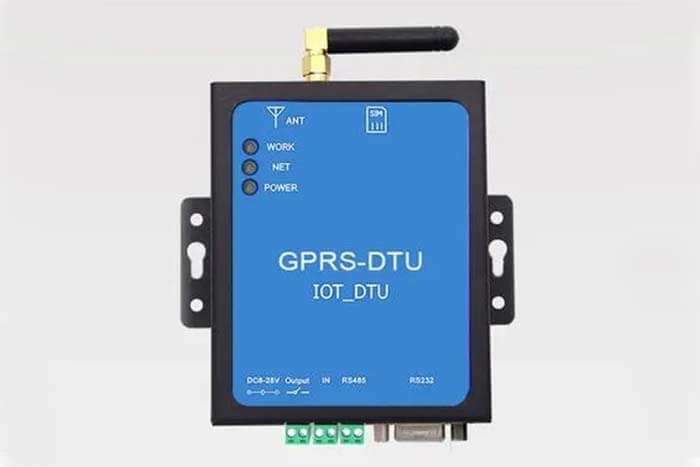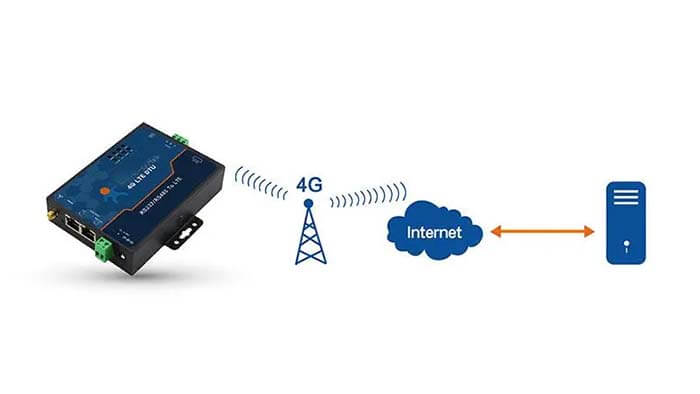After the read, you will know:
What is DTU (Data Transfer unit)?
What is DTU’s development history?
What is DTU’s working principle?
What is DTU’s functional configuration?
What is DTU’s Advantage?
What is DTU’s core function?
What is DTU’s extension function?
What is DTU’s application?
Application examples of DTU’s 7 major industries
What is DTU (Data Transfer unit)?
DTU (Data Transfer unit) is a wireless terminal device specially designed to convert serial data to IP data or convert IP data to serial data for transmission through wireless communication networks. DTU is widely used in meteorology, hydrology and water conservancy, geology, and other industries.
What is DTU's development history?
Data Transfer Unit (DTU) is a wireless terminal device designed to convert serial data to IP data or convert IP data to serial data for transmission over wireless communication networks.
What is DTU's working principle?

The most basic usage of DTU is to put a GPRS GSM LTE 4G-enabled SIM card in the DTU, register the DTU to the GPRS GSM LTE 4G network first after powering up, and then establish a connection with the data processing center through the GPRS GSM LTE 4G network.
This connection involves the wireless network operator, the Internet broadband provider, the user’s company network situation, and the user’s computer configuration, so all parts need to be configured properly to establish this connection.
In essence, the DTU and the data processing center establish a SOCKET connection, with the DTU as the SOCKET client and the data processing center as the SOCKET server.
There are TCP and UDP protocols for SOCKET connections, and the DTU and the center have to use the same protocol, which is generally configured with configuration software.
After configuring the IP address and port number of the DTU, the DTU is connected to the user’s equipment through the serial port, and the DTU is connected to hydrological, electric power, meteorological and environmental protection equipment and placed on site.
After the DTU is powered, it first registers with the mobile network and then sends a request packet to establish a SOCKET to the mobile, which sends the request to the Internet.
The server software of the center receives the request and establishes a connection and sends an answer message. the request message sent by the DTU is a packet on the Internet, and there are some reasons that prevent the center from receiving the connection request packet, so the connection cannot be established.
The most common is that the center’s computer has antivirus software, firewall, etc. to block these packets. The other is that the central computer is connected to the Internet through the router, and the data forwarding should be set up on the router so that the SOCKET connection can be established for two-way communication.
What is DTU's functional configuration?
Hardware Components
DTU hardware components mainly include a CPU control module, wireless communication module, and power supply module
What is DTU’s Advantage?
Rapid and flexible network formation, short construction period, and low cost.
Wide network coverage.
Good security and confidentiality performance.
Link support for always-on, per-traffic billing, and low user cost.
What is DTU's core function?
1) Integrated TCP/IP protocol stack
The GPRS GSM LTE 4G DTU is internally encapsulated with PPP dial-up protocol and TCP/IP protocol stack and has an embedded operating system, which can be regarded as the combination of embedded PC and wireless GPRS GSM LTE 4G MODEM in terms of hardware; it has the functions of GPRS GSM LTE 4G dial-up Internet access and TCP/IP data communication.
2) Provides serial data bi-directional conversion function
GPRS GSM LTE 4G DTU provides serial communication interfaces, including RS232, RS485, RS422, etc., which are all commonly used serial communication methods, and GPRS DTU is mostly designed to “transparently convert” serial data, that is, GPRS GSM LTE 4G DTU can convert the original data on the serial port into TCP/IP packets for This means that the GPRS GSM LTE 4G DTU can convert the original data on the serial port into TCP/IP packets for transmission without changing the original data communication content.
Therefore, GPRS GSM LTE 4G DTU can be connected to various user devices using serial communication without any modification to the user devices.
3) Supporting automatic heartbeat and staying permanently online
One of the advantages of GPRS GSM LTE 4G communication networks is that they support GPRS GSM LTE 4G terminal devices to be permanently online, so typical GPRS GSM LTE 4G DTUs are designed to support permanent online functions.
This requires the DTU to include features such as automatic dialing on power-up and using heartbeat packets to stay permanently online (when there is no data communication for a long time, the mobile gateway will disconnect the DTU from the center, and the heartbeat packet is a small data packet sent between the DTU and the data center before the connection is disconnected to keep the connection from being disconnected), support for automatic disconnection and reconnection, and automatic redial.
4) Support parameter configuration and permanent storage
As a communication device, GPRS GSM LTE 4G DTU has a wide range of applications. In different applications, the IP address and port number of the data center, the baud rate of the serial port, etc. are different.
Therefore, GPRS GSM LTE 4G DTU should support parameter configuration and save the configured parameters in internal permanent memory devices (usually FLASH or EEPROM, etc.). Once powered on, it will automatically work according to the set parameters.
5) Support user serial port parameter setting
The serial port parameters of different user devices are different. When DTU connects to the serial port of a user device, the DTU side should be set accordingly according to the actual parameters of the serial port of the user device to ensure normal communication and reliable data transmission of the user device.
What is DTU’s extension function?
The more professional GPRS GSM LTE 4G DTU also provides some extended functions, mainly including: supporting data center domain name resolution, supporting remote parameter configuration, remote firmware upgrade, supporting remote SMS/phone wakeup, supporting local serial port firmware upgrade, providing SMS channel, providing DTU online and offline level indication, etc.
More advanced DTUs can also provide users with secondary development functions; for example; communication plug-ins, DLLs, and interface documents so that users can modify the DTU according to their actual situation and improve the DTU product to make it more suitable for their needs.
What is DTU's application?
The main function of DTU is to transmit data from remote devices back to the backend center through wireless. To complete the data transmission, a complete data transmission system needs to be set up. Included in this system are DTU, customer equipment, mobile network, and back-end center.
At the front end, the DTU and the customer’s equipment are connected via 232 or 485 interfaces. After the DTU is powered up and running, it first registers with the mobile GPRS network and then establishes a SOCKET connection with the backend center set up in the DTU.
The backend center acts as the server side of the SOCKET and the DTU is the client side of the SOCKET connection. Therefore, only DTU can not complete the wireless transmission of data, but also need to have the cooperation of the backend software to use together.
After the connection is established, the front-end device and the back-end center can transmit wireless data through the DTU, which is bi-directional.
DTU has been widely used in electric power, environmental protection, LED information release, logistics, hydrology, meteorology, and other industry fields. The principle of the application is the same, despite the different industries of application.
Mostly, DTUs are connected to industrial equipment, such as PLCs, microcontrollers, and other automation products, and then establish a wireless communication connection with the backend.
With the increasing development of the Internet, the use of DTU is becoming more and more widespread. It provides information and industrial integration for various industries and between industries.
Application examples of DTU's 7 major industries
Electric power industry
- Electricity remote meter reading.
- Substation monitoring.
- Power line monitoring.
- Distribution network column switch monitoring system.
Water industry
- Water quality monitoring.
- Reservoir gate remote control system solution.
- Water conservancy GPRS scheduling system application solution.
- Water pipeline network monitoring system.
- Reservoir automatic monitoring system.
Petroleum industry
- Remote monitoring of oil and gas wells.
- GPRS/GSM/LTE 4G remote oilfield automation monitoring system.
- Gas pipeline network monitoring system solution.
Municipal industry
- Street light remote monitoring management.
- Pipe network remote monitoring.
- City energy consumption monitoring.
Environmental protection industry
- Pollution source monitoring.
- Atmospheric environment monitoring.
- Noise monitoring.
- Dust monitoring.
Agricultural applications
- Greenhouse remote monitoring management.
- Aquaculture monitoring management.
- Agricultural water pump monitoring management.
Other industries
- Warehouse monitoring and management.
- Elevator remote monitoring.
- Remote crane management system.
- Industrial energy consumption monitoring applications.
- Gas station GPRS GSM LTE 4G data collection system.
- GPRS GSM LTE 4G weather information collection system
Besides this What is DTU article, you may also be interested in the below articles.
What Is The Core 5G NR Technology?




